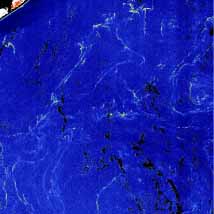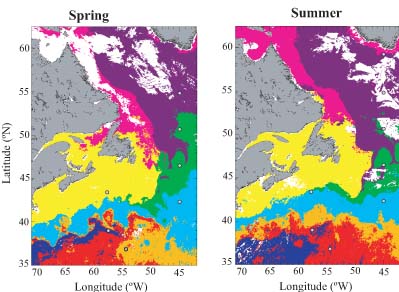

|
|
 The IOCCG will be sponsoring two students from Africa (Kwame Adu Agyekum from Ghana, and Lisl Robertson from South Africa) to attend an ocean-colour training course in Mombasa, Kenya (24 September - 5 October 2007). The course entitled "Methods and Applications of Ocean Colour Remote Sensing in African Coastal and Regional Seas" is being organised by the EC Joint Research Centre (Ispra, Italy) and the Kenya Marine Fisheries Research Institute (KMFRI). Other sponsors include GEO, WIOMSA, IO-GOOS, EU-IOC ReCoMaP project, and BCLME. The course is designed to provide the theoretical basis of ocean-colour satellite measurements, as well as key applications in monitoring and managing the coastal zone, and in protecting marine ecosystems and resources. The course will be attended by 18 students (research scientists, environmental managers and graduate students involved in marine research and coastal management) from Africa and Western Indian Ocean countries.
The objectives of this advanced Dragon training course are to stimulate and support the exploitation of ESA EO and TPM remote sensing data for ocean applications, and to introduce available software tools and methods for the exploitation of ERS, Envisat, TPM and Explorer mission satellite data. Invited lecturers include IOCCG Committee members Drs. Roland Doerffer (GKSS, Germany), Pan Delu (SIO, China) and Peter Regner (ESA) who will lecture on MERIS ocean colour principles, atmospheric correction and water constituents retrieval algorithms, products and applications, as well as practical exercises with MERIS data using BEAM software.
Using optical radiance data from MERIS, Drs. Jim Gower and Stephanie King (Institute of Ocean Sciences, Canada) and Chuanmin Hu (University of South Florida, US) were able to identify extensive lines of floating Sargassum seaweed in the western Gulf of Mexico. This is the first time that Sargassum has been identified from space. The discovery was made using the MERIS Maximum Chlorophyll Index (MCI) which provides an assessment of the amount of chlorophyll in vegetation to produce detailed images of chlorophyll per unit area. MERIS is uniquely suited for this because it provides images of above-atmosphere spectral radiance in 15 bands, including three bands at wavelengths of 665, 681 and 709 nm, in order to measure the fluorescence emission from chlorophyll-a. The 709 nm band of MERIS is not present on other ocean-colour sensors, and was essential for the detection of Sargassum. The MCI index was also used to find intense phytoplankton blooms in the Antarctic.  Sargassum as seen by MERIS. Credit: ESA
The scientists are now using a sophisticated processing algorithm and powerful grid computing to determine global estimates of Sargassum biomass and its contribution to ocean productivity, using 5-years worth of MERIS data.
For further information see:
|
August 1st marked the 10-year anniversary of the launch of NASA’s SeaWiFS mission, and September 18th will mark the anniversary of the continuous global data record, resulting in an unprecedented 10-years of continuous observations of the earth's biological, ecological, and chemical response to climate change. The SeaWiFS mission has resulted in enormous scientific returns for researchers studying a wide variety of questions, and has resulted in a large number of publications and operational applications. The key research findings made during the ten years of this highly focused mission will be highlighted next month by NASA’s Public Affairs Office, in conjunction with the Ocean Biology and Biogeochemistry research program. Congratulations to the team at NASA for an extraordinary accomplishment. Recently NASA announced that it had reached and signed a new contract with GeoEYE (formerly ORBIMAGE) that will provide the ocean colour research community with continued access to the global (4-km) SeaWiFS data set.
Users can now easily find ocean colour satellite scenes for which there are corresponding in-situ data in the SeaBASS data holdings, using the Level 1 and 2 browser from NASA’s Ocean Biology Processing Group (http://oceancolor.gsfc.nasa.gov/cgi/browse.pl). There are currently more than 30,000 in situ records available to the browser covering missions from CZCS (November 1978) up through the currently operational ones (although no in-situ data is currently available for 2007). The browse images have the location of the in-situ observation(s) marked on them and the actual in-situ values are presented in a table on the same page. For more information on how to use this new feature, please see the help page.
Several new references have been added to the IOCCG Bibliography, including an article by Devred, Sathyendranath and Platt (2007) entitled “Delineation of Ecological Provinces using Ocean Colour Radiometry”, which will appear as the “Feature Article” in the next issue of Marine Ecology Progress Series (September 2007). Several years ago, Longhurst et al. (1995) proposed a partitioning of the global ocean into 56 biogeochemical provinces based on physical forcing. The provinces were used as a template on which photosynthetic and other parameters were assigned for computation of primary production. In their paper, Devred et al. developed a new, objective method to delineate dynamic province boundaries for the Northwest Atlantic region, to avoid the limitations arising from fixed provinces with rectilinear boundaries. They performed a statistical analysis on composite SST and chlorophyll images from MODIS, as well as ancillary data, to elucidate the spatial variation of the province boundaries for three different seasons. Ecological provinces were found to undergo changes over an annual cycle due to the seasonal warming of the water. Dynamic partitioning of ecological provinces in such a way can play an important role in understanding biological and physical processes in the ocean ecosystem, and improve interpretation of the results.  Dynamic assignment of ecological provinces in the Northwest Atlantic in the Spring and Summer of 2003 (Devred et al., MEPS, September 2007).
Several new positions have been added to the Employment Opportunities section of the IOCCG web page, including a Project Engineer for the "BOUSSOLE" Project (France), and a position in ocean optics at Lamont Doherty Earth Observatory of Columbia University (USA). |
|
|
Material for possible inclusion in the IOCCG Newsletter should be submitted to the Project Scientist. Subscription to the IOCCG Mailing List.Participants receive a brief summary of the IOCCG Newsletter by e-mail (quarterly), as well as hard copies of IOCCG Reports as, and when, they become available.
|
|
|